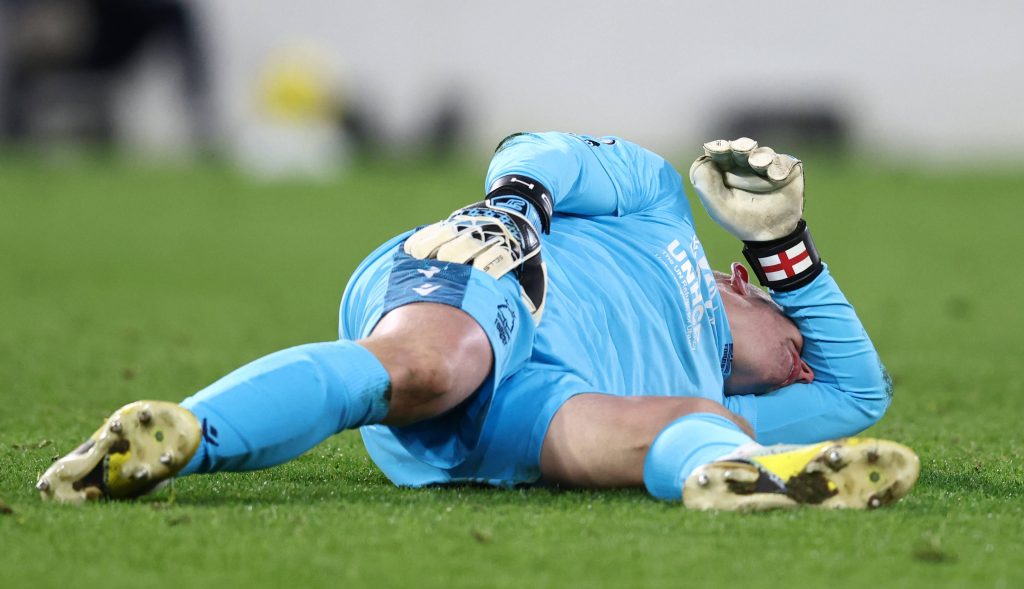Jason McKenna, the Head of Content at Premier Injuries, analyses the quantities and costs of various injuries in the English Premier League
We are in an era of unprecedented levels of strain placed on players, making this season one of the hardest ever for injury prevention. Premier League teams already have the largest loading pressures placed on squads with the most games in Europe’s Top 5 leagues; it is also the most physically intense league (measured by running loads and the volume of high intensity activities). But the 2022/23 season is especially interesting for analysts as an already incredibly busy fixture schedule was added to in order to shoehorn in the Winter World Cup. Load levels have never been so high on players and so it is no wonder that managers are regularly discussing the need for less, not more games, for players to recover.
This means it is important to appraise the injury records and analyse the costs to teams. When a player is injured there is a footballing loss as well as a monetary cost. This article will delve into the latest Premier League injury data to discuss some of the most interesting stories emerging from clubs, individual players and the league itself.
Before we begin looking at the numbers I will explain the methodology of injury cost calculation used. “Cost” relates to any injuries that saw a player miss one Premier League match or more. Clubs may say that a player is “injured” and while these data are recorded, players sometimes they play through their problems and so these incidents have not been included.
In addition, at the other end of the spectrum, some injuries are so long term that they have been carried over from last campaign into this one. Any injury that extends past the end of the season, for example Armando Broja’s season-ending ACL Injury, was rounded to the final day of the season as I have given a cost up until the point. To simplify the data I also removed any absences due to yellow or red cards, tournaments, internal disciplinary matters, personal reasons and when they have been unable to face their parent club. The data used has been from the Premier Injuries database that tracks every injury in the Premier League and has been coupled up with the salary information from Capology via FB Ref.
The Most Costly Injuries
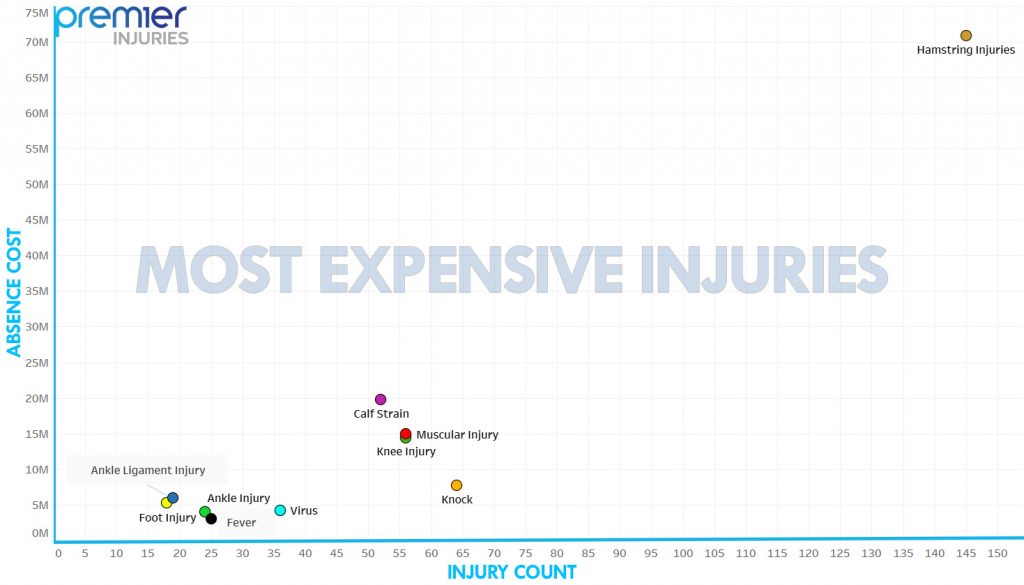
Hamstring Pings
Hamstring Injuries are the most common in top flight football. Nothing else comes close in terms of incidence rate. In the 2022/23 campaign there were 118 hamstring strains, eight hamstring surgeries and 19 incidents of tight hamstrings. This dwarfs the next most common reason for injuries: these are “knocks”, with 64 incidents, muscular injuries, with 56 incidents, and knee injuries, with 56 incidents.
The reason why this muscle group is injured so often is due to the physical demands of football and human physiology. The hamstring is vitally important for the explosive power created by players but is put under a lot of strain every match. It is used in almost every movement giving thrust to players and is at most risk during sprints due to the rapid lengthening and shortening of the muscle: the hamstring reaches 110% of its length during periods of running.
Fatigue plays a big factor in why these injury occur and the aforementioned tight schedule means that players are not resting enough to prevent these injuries. The problem with a hamstring injury is not just the short term time out, but it also affects players’ long term injuries too. Previous hamstring injuries place a player at a much higher risk of future injury and this season’s data is dominated by those players who have been plagued with hamstring issues.
Ben Chilwell (injury costs totalling £2,524,285), Naby Keita (£1,660,000) and Raphael Varane (£1,505,714) are amongst the most expensive standalone injuries we have seen this season and are the archetypal examples of players who have seen a recurrence of their injury due to previous hamstring issues. Once a player has experienced one hamstring injury their load must be managed carefully as there is a 16-60% chance of recurrence.
The calculation of Hamstring Injuries (hamstring strains + tight hamstrings + hamstring surgery leads to a grand total of £70,887,571 lost by Premier League clubs. The number is gargantuan and the risk is that as we push players with more and more matches each season, the rates of injury are only going to get higher. Medical staff can only do so much prevention work as this soft tissue injury is most exacerbated by load issues rather than in-game contact scenarios.
The Dreaded Three Letters
The other injury worth highlighting with regards to the 2022/23 season is one of the worst a footballer can experience, one to the ACL. The Anterior Cruciate Ligament (ACL) is one of the four major ligaments in the knee and is responsible for the stability of your knee, which helps quick movements from side to side so a player can pivot quickly. However, due to the location of the ACL being intra-articular (meaning inside the joint), it has a poor blood supply and this impairs its ability to heal.
Although they are only the seventh most costly injury in total absence cost (£9,499,857), the cost-per-injury is incredibly high as there were only eight such injuries this season; on average they account for fewer than 1% of injuries per season.
The timeline is costly in monetary terms, as it sees players out on average for nine months. But the cost also comes from non-monetary factors as well. Although ACL injuries have a 95% return-to-play rate, only 65% of players return to pre-injury levels of physical output and, according to Dr Matt Provencher of the Steadman Clinic, the reality is that players take two full years to get back to where they once were, if ever. This means that teams lose a player for nine months’ playing time, but as much as 24 months of their peak output. For players this may mean that they lose their place in the team. Nine months is a long time in football: it could see a new manager come into a club and a new play style deployed. Teams have to adapt their tactics or style in order to fill the hole left by the player. The sad reality is that there are so many measurable and immeasurable variables that means that this is one of the most costly to players careers.
Returning to play also does not assure safety. The risk of re-injury is incredibly high once you start playing competitively again. There is a 10-15% risk of sustaining a second ACL injury after return to play and ACL injuries are also associated with many secondary injuries, especially in that initial period of comeback. The lack of competitive football leads to deconditioning (changes which occur as a lack of activity and can bring about fatigue or a lack of resilience) and this is why players are reintroduced conservatively in the period when they are brought back into the first team. Finally, there is also a likelihood of kinesiophobia that players have to combat. The return from the injury is mentally and physically gruelling and many players have to stop their fear of getting injured again.
Teams and Player Evaluations

Chelsea: Big Spenders
It was a season to forget for Chelsea. The transfer approach of new owner Todd Boehly reaped no rewards for the side with the Blues having their worst Premier League performance ever. And worries will carry into next season as one of the reasons for their poor performances was the team having the worst injury record in the league.
This might be attributed to a behind-the-scenes issue that persisted through the season. With a changeover in ownership Chelsea also had a mass huge exodus of backroom staff. A private company was brought in, but the injury issues persisted and the situation became so bad at the club that some of those who were relieved of their duties had to be rehired. However, there could be multiple, other factors at play to which we are not privy (one of the difficulties assessing injuries is that clubs are, understandably, legally, and ethically, pretty private about details).
The problems with medical staff seriously dented the club’s long term relatively good injury stats. This season all their numbers totally collapsed. Under the previous six managers the team had averaged 5.65 injuries per 1k minutes played, with their previous worst incident rate being under Guus Hiddink at a rate of 6.5 injuries per 1k minutes played. However when Graham Potter took over the role as manager the incidence rate of injuries almost doubled to 11.1 injuries per 1k minutes played.
This has seen the team top the table for total games missed (216), have the highest number of days lost to injury (1836) and the most time loss injuries (48). Due to their injury record Chelsea lost £45,984,285 in injuries which is over £11,000,000 more than second placed Manchester United and £40,000,000 more than the Premier League average of £14,959,811.
This is not just a symptom of their large squad or that they have the third largest squad wages in the Premier League. They have also had limited availability amongst many of their players, with Kai Havertz being the only outfield player in the team to have played 2500+ minutes in the Premier League this season. There have been serious availability issues to multiple players. The worry is emphasised by the fact that Chelsea had four players in the top 10 accumulative most expensive injuries this season with N’Golo Kante (£9,652,857) and Reece James (£6,392,857) occupying the top two spots.
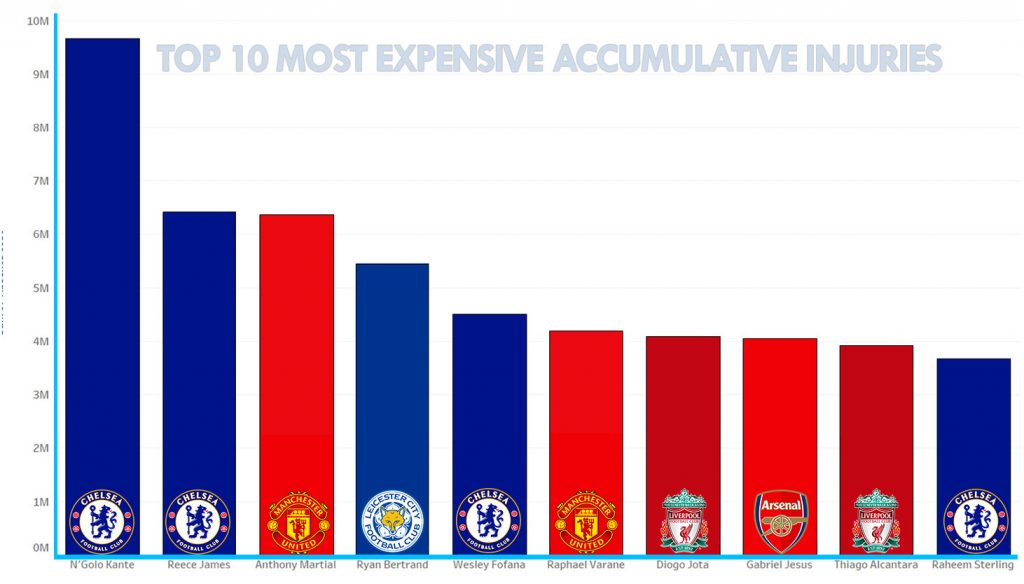
One of the most important issues Mauricio Pochettino will have to grapple with is getting his players a good preseason so that they are well conditioned for the campaign ahead. The issue that has plagued Chelsea for a few seasons is that players that are so integral to the success of the team, Ben Chilwell and Reece James, are also injury prone. The management of the side will also have to revolve around how to best control their loads.
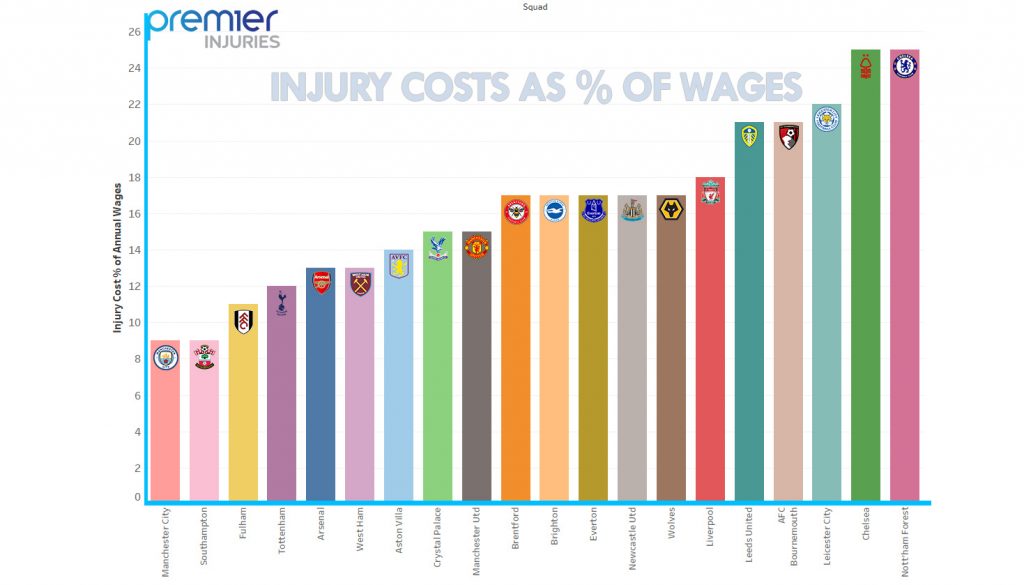
Nottingham Forest’s Luck Cannot Continue
Steve Cooper managed to make the City Ground a bit of a fortress, but it was a battleground too. The team escaped the drop but had one of the worst injury records in the league. This cannot continue into next season if they want to be able to continue their Premier League journey.
In terms of player availability there was little consistency in the team. Only two of their players managed over 2.5k mins this season which illustrates how disrupted the teams season was by absences. Dean Henderson was their most costly player in terms of injury cost accumulation. His total time out of 145 days meant that the team lost £1,928,571 (according to The Athletic, although Henderson was on loan from Manchester United, Forest paid his salary in full). But the season saw frustrations all over the pitch. Star signings Morgan Gibbs-White and Taiwo Awoniyi missed significant stretches of the season. Although Gibbs-White played 2,971 minutes, he had five different absences that totalled 59 days missed throughout the campaign. Awoniyi was absent for 87 days from January until March. Jesse Lingard, their joint second highest earner, played just 923 minutes and cost the team £971,428 in lost wages.
The team are in the bottom two for almost every measurable injury dataset. But most worrying is what is displayed in the graph above. The team had the joint largest amount of their annual wages lost to injuries: 25% of their spending on player salaries were on injuries and this is not a sustainable outlay for a newly promoted side, even if they are being bankrolled by billionaire Evangelos Marinakis.
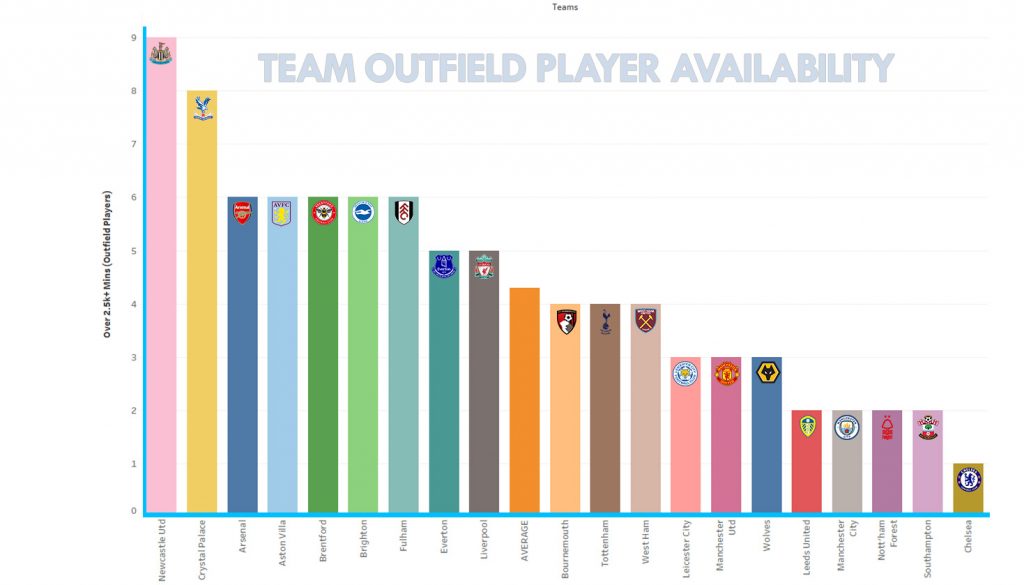
Newcastle: Bad or Good?
Looking at the numbers for Newcastle is a great lesson in context. If you were to look at just the amount of time loss injuries then you would be worried as the team had the second most (39), behind only Chelsea, and the eighth most costly injury total of £13,753,571. However, context is key. It is important to assess who was absent.
Of Newcastle’s 10 longest injuries, only two could be regarded as first team players. The people with the most time on the sidelines were individuals who would not be vying for places. Emil Krafth was both the player with the longest absence, 278 days, and the most expensive injury with £2,184,285 lost. The only real concern for the Magpies was the long term absence of Alexander Isak, who was the second most expensive injury for the team; his time out totalled £2,057,142 and 125 days absent. The Swedish striker had multiple setbacks in his recovery period from what initially appeared as a fairly innocuous injury. But in the end, these issues were resolved and he had a great debut season in the Premier League.
Overall the story of the team is one of success. Nine outfield players clocked over 2500 mins. This is an almost unprecedented level of availability for a top league, with 90% of players playing more than 73% of the season. This core nucleus of the team were consistently available for selection through the season, which is part of the reason for the Magpies having such a fantastic season. This can even be seen with the load management of Callum Wilson. He has the eleventh most minutes in the team and even though he was in and out of the team at times this saw him have his most productive season even in terms of goals and assists. The once perennially injured player has now been turned into one of the league’s most fearsome strikers with a clever understanding of his physical capabilities. The Champions League will be more of a test for the squad, but Newcastle certainly seem well prepared for the challenge.
Attention has to be given to the results from the backroom staff at the club. Long time club doctor Dr Paul Catterson has paired up well with Daniel Hodges, who became Head of Performance at Newcastle United after Eddie Howe brought him over from Bournemouth in 2021. Behind the scenes these two have spearheaded changes embracing new technologies, such as Artificial Intelligence, in order to ensure their players stay fit. The work is meticulous and they pay a lot of attention to detail. Eddie Howe has also raised well-being and comfort for players by allowing them to seek treatment from trusted medical partners in their homelands. For example, Newcastle United have their own cryotherapy suite, but Allan Saint Maximin was allowed by the club to seek cryotherapy treatment in France to help with soft tissue injuries and in an environment where he felt more at ease. Adding to this, Eddie Howe has overseen an overhaul of the club with intense fitness levels but also careful handling of players based on their needs. This has seen carefully created individualised training schedules for players. This is a story of multifactorial improvements and it is not down to just one area but ultimately an accumulation of many successful decisions taken by Eddie Howe. Decisions are always taken in consultation as it is a collective approach of backroom staff whom he trusts and there has been buy-in to the practices from players.
Fulham Overperforming
Almost in stark contrast to their fellow promoted team Nottingham Forest, the Cottagers were seriously impressive with their injury record. The team needs a lot of praise as a newly promoted side with very little wastage on injuries. The numbers are quite staggering and it could be argued that they had the second best injury record for the 2022/23 campaign. Breaking it down, they had the second lowest proportion of annual wages spent on injuries, the joint fewest total injuries and joint second best injuries per 1k mins of exposure. Their availability was sensational: six outfield players clocked up over 2.5k+ minutes, and this would have probably been more if Aleksander Mitrovic had not been banned for such a long period.
The ability of the team to keep their best players fit may also explain their ability to “overperform” this season. Fulham blew away opposition in the Championship and gained promotion breaking many records, but few foresaw that they would be one of the teams fighting for a European spot coming to the end of the season. Availability is one of the biggest, and yet most under-appreciated, attributes of any player. As good as you are, if you cannot contribute to games then you will not help your team.
There is obviously good work going on behind the scenes. The medical department needs praise but Fulham’s squad also seems to profile well for continuing this trend as their players are used to high loads from their Championship season. There has been a core group of players who have played lots of minutes from the 2020/2021 season and the high availability rates shows that these players are able to meet high workload demands. Tim Ream, Antonee Robinson, Harrison Reed, and Bobby Reid are all examples of this carry-over, plus Aleksander Mitrovic would likely have joined this group too. Also, smart spending on transfers and a carry-over in their squad from their previous time in the Premier League meant a lot of them also had top flight experience.
Although not based on data, this may also serve the team well in avoiding the “second season syndrome” that has plagued some high performing promoted teams. Looking at the example of Wolves, the side seemed to be able to perform so well in their first few seasons returning to the Premier League due to the amazing work of keeping players fit. Their medical team were the envy of the league as they did not have a hamstring injury for two seasons. Brentford have also been able to remain consistent as they have had one of the lowest incident rates in both of the Premier League seasons. As the old adage goes “correlation does not imply causation”, but it is true that if you are a small club working with limited resources keeping your squad fit is a huge marginal gain to have over your opponents.
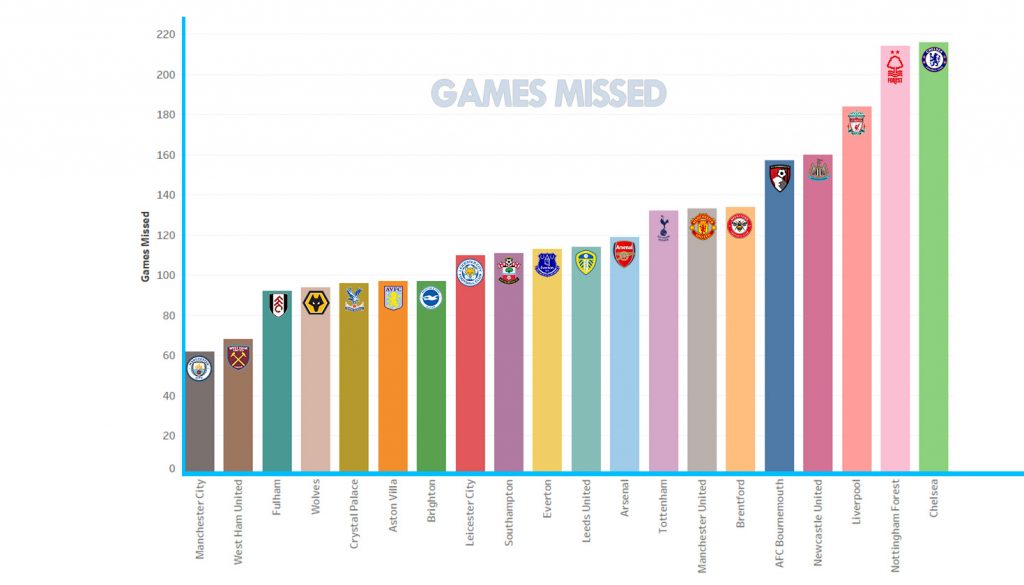
Boring Manchester City
Finally we end with the best team in the league. Lo and behold it is Manchester City once again. The club are topping the table on and off the field with an absolutely incredible data set. The team only had two players who had 2.5k+ minutes on the pitch, but this was not down to injury issues. The strength of the squad allowed the team to almost perfectly manage the load management of their Treble winning team. The player with the largest absence cost was John Stones, who spent 82 days on the sideline with two muscular injuries and two hamstring strains, totalling £2,928,571. But this was not even in the top 15 most expensive accumulative injuries for the season.
Most of the problems that kept players out were short term, with a league low of 62 games missed and only 447 days lost; the team also lost only 9% of their annual wage budget to injuries. Added to this, the team have the fifth best injuries per 1k mins played data despite going deep into so many tournaments, which shows how well the squad was managed all season. This is all on top of the fact that the start of the season saw the team adapting to the play style of Erling Haaland and then in January there was the swift exit of Joao Cancelo from the side.
Conclusion
I wish to conclude with something that I often say when asked about injuries. Just because a team has a “bad” injury record, it should not immediately imply a criticism of medical departments. In an era of extreme reaction and angry vitriol aimed at those involved in football, staff helping players recover are often given unfair criticism and abuse. I hope that this article has given you an insight into other ways of looking at injuries. Like many of football’s fantastic statistics, sometimes the headline grabbing numbers can overlook the real nuance behind the story. There are a plethora of complicated reasons why players get injured and often the Return To Play data amongst the “worst” sides indicate how well these teams are doing at getting players back before expected return dates. Injuries can be complicated and follow-ups do not always mean mismanagement; it is sometimes just down to the facts of physiology.
Header image copyright IMAGO / Darren Staples / Sportimage

